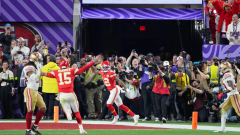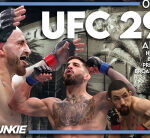
Kirby Lee-USA TODAY Sports
Dre Greenlaw is one of the better inside linebackers in the NFL. He’s the man who draws the bulk of San Francisco’s coverage assignments in the middle of the field near the line of scrimmage. He racked up 171 targets in 30 games the last two years, knocking down 10 passes in the process.
While he’s not infallible, he’s a deterrent. In the first half of Super Bowl 58, the Chiefs had attempted only a pair of passes in the middle of the field and alternated between short, intermediate and deep shots against the Niners’ two-high safety attack.
Greenlaw left the game before halftime thanks to an Achilles injury, leaving backup Oren Burks to fill that void. But Burks couldn’t contain Kelce, creating space for short throws that paved the way for four different scoring drives of at least 47 yards over the final two quarters and overtime. Kelce had one catch for one yard in the first half; he finished the game with nine for 93.
Mahomes completed 16 of his 17 passes over the middle for 153 yards. All but five of his 34 completions came within 10 yards of the line of scrimmage. Brock Purdy was the more effective passer downfield, but it was the Chiefs’ dinks and dunks that won the game.

via nextgenstats.nfl.com
With movement and mesh, Kansas City created a light lift, heavy impact passing game with a 49 percent success rate — particularly notable against a Niners’ defense, whose 43 percent success rate allowed on dropbacks ranked seventh-best in the league. So why was this a big deal? Because…

Stephen R. Sylvanie-USA TODAY Sports
San Francisco won consistently in its four-on-five battles with the Chiefs’ offensive line. Javon Hargrave — who has now lost to Kansas City in the Super Bowl in back-to-back years, woof — commanded double teams, leaving the three linemen around him in one-on-one situations. This was not ideal for KC.
A solid safety duo meant the deep passing game that never really clicked for the Chiefs in 2023 would remain in neutral. The exception was one big throw that probably should have been intercepted if not for a misplay by the otherwise sturdy veteran Tashaun Gipson.
Mahomes connects with Hardman deep!
📺: #SBLVIII on CBS
📱: Stream on #NFLPlus https://t.co/dClcEDViWl pic.twitter.com/yUc00MtP84— NFL (@NFL) February 12, 2024
That left space to pick spots between the rising tide of the pass rush and the sentries at the back of the secondary. All Mahomes had to do to find them was escape pressure. That’s easier said than done, but in the end he remains Patrick Mahomes. He found space, connected on easy throws and thrived, roughly seven yards at a time.
He didn’t have to win a shootout, because…

Steph Chambers/Getty Images
Brock Purdy played a competent game and was one defensive stand away from a Super Bowl ring. When he had time to step into his throws, he found open targets and delivered timely strikes.
But he had long stretches of ineffectiveness. There were two reasons why.
The first is Chris Jones, who launched himself into free agency with proof he’s the game’s most impactful interior lineman. Jones didn’t have a sack and only racked up four tackles, but his 3.95-yard average distance from the quarterback was the lowest among any player in Super Bowl 58. He was perpetually ready to ruin Purdy’s night.
give Chris Jones all the money. saved 6 points from 25 yards away pic.twitter.com/ig9EcXs4CL
— Christian D’Andrea (@TrainIsland) February 12, 2024
The second is that defensive coordinator Steve Spagnuolo ensured his aggression was threaded with nuance. Spagnuolo bet on his cornerbacks in big moments, trusting L’Jarius Sneed and Trent McDuffie in single coverage in order to overwhelm Purdy with a sea of red in big moments.
Here it was on third-and-four when a first down could have given San Francisco the leverage to win the game in regulation.
Spags gave the order to burn the boats pic.twitter.com/qiuCli9dUM
— Christian D’Andrea (@TrainIsland) February 12, 2024
That’s Spagnuolo’s whole thing; he’s not as aggressive as Brian Flores was in Minnesota, but his 32.9 percent blitz rate was seventh-highest in the NFL. When San Francisco opted to compress its offense around the line of scrimmage, Kansas City countered with extra pressure on the edge — sometimes implied via stunts and sometimes through full-on blitzes.
The result was a game where Purdy rarely looked comfortable for long. After an 8-of-11, 105-yard start in his first three drives, the second-year QB was 15 of 27 for 140 yards — a drop from 9.5 yards per attempt to 5.2. He was forced into back-foot lobs into coverage or rushed thro




